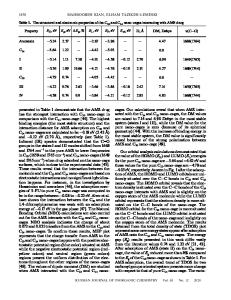Mixed Phonon Mode in C 24 Rb
- PDF / 234,145 Bytes
- 4 Pages / 420.48 x 639 pts Page_size
- 53 Downloads / 1,054 Views
SATORU FUNAHASHI, TAMOTSU KONDOW* AND MASASHI IIZUMI Division of Physics, Japan Atomic Energy Research Institute, Tokai-mura, Ibaraki-ken 319-11, Japan and *Department of Chemistry, Faculty of Science, University of Tokyo, Bunkyo-ku, Tokyo 113, Japan
the
ABSTRACT The [001] L-mode phonon excitations of C2 4 Rb were studied by neutron inelastic scattering in the region where the phonon dispersion curve of the acoustic branch anticrosses the transverse Einstein oscillation level. The interaction between the longitudinal collective mode and the transverse Einstein mode could be observed only in the temperature region where the rubidium atoms form an ordered structure. The mechanism of the interactions between the transverse and longitudinal modes is discussed in relation to the symmetry of the atomic position of rubidium.
INTRODUCTION Recently, intensive studies on lattice dynamics of alkali metal graphite intercalation compounds (GIC's) have been carried out both theoretically and experimentally [1]. The second order Raman scattering is a powerful tool to investigate the overall features of the phonon spectra up to high frequency. For the low energy phonons, on the other hand, the neutron inelastic scattering technique will give dispersion curves of the entire Brillouin zone if sufficiently large single crystals are available. In the case of a sample grown from highly oriented pyrolytic graphite (HOPG) the reciprocal lattice vectors are still well defined on the c*-axis. Therefore, we can obtain the dispersion curves of the [001) L-mode phonons by measuring neutron inelastic scattering for the scattering vector Q on the c*-axis [2-5]. In the phonons of the [001] L-mode, both the wave vector and the atomic displacements are parallel to the c-axis. For the lower frequency branches, all the atoms in a plane perpendicular to the c-axis move in phase along the c-axis. Consequently, the dispersion curves of these branches should reflect the c-axis component of the forces between the atoms which are not in the same plane perpendicular to the c-axis. Linear chain models with areal masses can represent the phonon dispersion curves of these modes, and the experimental results have been analyzed on the basis of this kind of model. In the case of C2 4 Rb, a second stage GIC, the nearest neighbor carbon-carbon (C-C) interlayer force is nearly equal to that in pristine graphite [4]. The carbon-alkali metal interlayer force can be written in terms of the exponential of the interlayer distance, as proposed by Dresselhaus et al. [3]. It has been found in C2 4 Rb that, though the second neighbor C-C force across the rubidium layer is only about 12 percent of the nearest neighbor C-C interlayer force, it is necessary to include this force in order to reproduce the experimental results. Magerl and Zabel [2] reported that the dispersion curves of the third stage compounds can be accounted for by a one-dimensional shell model but not by the simple linear chain model. Another recent discovery, which was made by the present authors [4,5],
Data Loading...











